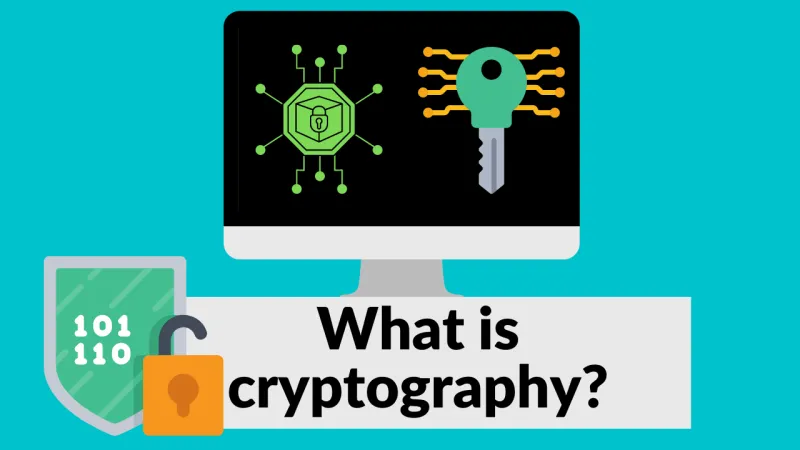Science of Cryptography: Safeguarding Finance Transactions in the Digital Age
Table of Contents

Introduction
In an era where digitalization permeates every facet of our lives, from online shopping to mobile banking, the need to secure sensitive information has never been more critical. Cryptography, the practice of securing communication and information through mathematical techniques, has played an instrumental role in this endeavor. This article delves deep into the world of cryptography, exploring its pros and cons, its relevance in finance transactions, the subjects studied within the field, and whether cryptography is primarily a science or engineering discipline. It will also provide a comprehensive set of questions and answers to enhance understandingUnderstanding Cryptography
1.1 What is Cryptography?
Cryptography, derived from the Greek words “kryptós” (hidden) and “gráphein” (to write), is the science and art of designing secure communication systems and techniques to protect data from unauthorized access or alterations. It is a multidisciplinary field that combines elements of mathematics, computer science, information theory, and electrical engineering. Cryptography is employed to ensure the confidentiality, integrity, and authenticity of information in various applications, including finance transactions.

1.2 History of Cryptography
The history of cryptography is rich and dates back thousands of years. Ancient civilizations, including the Egyptians and Greeks, used simple substitution ciphers to protect their sensitive messages. One of the most famous historical cryptographic systems is the Caesar cipher, attributed to Julius Caesar, which involved shifting letters in the alphabet by a fixed number.
In the modern era, the advent of computer technology and the need for secure communication in military and diplomatic contexts led to the development of more sophisticated cryptographic techniques. Notable milestones include the invention of the Enigma machine during World War II and the subsequent emergence of public-key cryptography in the 1970s.
1.3 Goals of Cryptography
Cryptography serves several primary goals:
- Confidentiality: Ensuring that sensitive information remains hidden from unauthorized parties. Encryption is a fundamental tool for achieving confidentiality.
- Integrity: Guaranteeing that data has not been tampered with during transmission or storage. Cryptographic hash functions play a crucial role in maintaining integrity.
- Authentication: Verifying the identity of parties involved in communication. Digital signatures and authentication protocols help establish trust.
- Non-repudiation: Preventing individuals from denying their involvement in a transaction or communication. Digital signatures also contribute to non-repudiation.
1.4 Types of Cryptography
Cryptography can be categorized into two main types:
1.4.1 Symmetric Cryptography
Symmetric cryptography, also known as secret-key cryptography, employs a single secret key for both encryption and decryption. The key must be kept secret and shared only between the parties involved in communication. The most common symmetric encryption algorithms include the Data Encryption Standard (DES), Advanced Encryption Standard (AES), and Triple Data Encryption Standard (3DES).
1.4.2 Asymmetric Cryptography
Asymmetric cryptography, or public-key cryptography, uses a pair of keys: a public key and a private key. The public key is freely available and is used for encryption, while the private key is kept secret and is used for decryption. This approach allows for secure communication between parties who have never met before and do not share a secret key. Well-known asymmetric encryption algorithms include RSA (Rivest–Shamir–Adleman), Diffie-Hellman, and Elliptic Curve Cryptography (ECC).
1.5 Cryptographic Algorithms
Within symmetric and asymmetric cryptography, various cryptographic algorithms have been developed. These algorithms determine how data is transformed during encryption and decryption processes. The choice of algorithm depends on factors such as security requirements, computational efficiency, and key management.
1.5.1 Symmetric Cryptographic Algorithms
- AES (Advanced Encryption Standard): Widely adopted and considered highly secure, AES is a symmetric block cipher that operates on fixed-size blocks of data.
- 3DES (Triple Data Encryption Standard): An enhancement of the original DES algorithm, 3DES applies DES encryption three times with different keys for added security.
- Blowfish: A symmetric block cipher known for its speed and simplicity.
1.5.2 Asymmetric Cryptographic Algorithms
- RSA (Rivest–Shamir–Adleman): Named after its inventors, RSA is a widely used public-key cryptosystem that relies on the difficulty of factoring large numbers.
- Diffie-Hellman: Primarily used for key exchange, this algorithm allows two parties to agree on a shared secret key over an insecure communication channel.
- ECC (Elliptic Curve Cryptography): Known for its strong security with relatively short key lengths, ECC is particularly suitable for resource-constrained devices.
1.6 Applications of Cryptography
Cryptography plays a pivotal role in numerous applications across various industries. Some notable applications include:
1.6.1 Secure Communication
- Secure Messaging Apps: End-to-end encryption, enabled by cryptographic algorithms, ensures that only the intended recipients can read messages.
- Virtual Private Networks (VPNs): VPNs use cryptography to establish secure and private communication channels over the internet.

1.6.2 Information Security
- Data Encryption: Sensitive data is encrypted before storage or transmission, making it unintelligible to unauthorized users.
- Secure File Storage: Cryptographic techniques are used to protect files and data stored on devices or in the cloud.
1.6.3 Authentication
- User Authentication: Cryptography underlies secure login systems, including the use of passwords and two-factor authentication (2FA).
- Secure Access Control: Access to physical locations or digital resources can be controlled using cryptographic access cards or tokens.
1.6.4 Digital Signatures
- Document Signing: Digital signatures ensure the authenticity and integrity of electronic documents, making them legally binding.
- Code Signing: Software developers use digital signatures to verify the authenticity of code and updates.
1.6.5 Finance Transactions
- Online Banking: Cryptography secures online banking transactions, protecting sensitive financial data during transfers and payments.
- Cryptocurrencies: Cryptocurrencies like Bitcoin rely on blockchain technology, which incorporates cryptographic techniques for secure transactions and wallet management.
The Pros and Cons of Cryptography
Cryptography offers a plethora of benefits, but it is not without its drawbacks. Understanding the pros and cons is essential for informed decision-making in its application.
2.1 Pros of Cryptography
2.1.1 Security
- Data Confidentiality: Cryptography ensures that sensitive information remains confidential, preventing unauthorized access.
- Data Integrity: Cryptographic hash functions protect data from tampering during transmission or storage.
- Authentication: Cryptography verifies the identity of parties involved in communication, reducing the risk of impersonation or fraud.
2.1.2 Privacy
- Personal Privacy: Cryptography safeguards personal information, enabling individuals to protect their digital identities.
- Secure Communication: Cryptography allows for private and secure communication, even in potentially hostile environments.
2.1.3 Trust
- Digital Signatures: Digital signatures build trust by verifying the authenticity of documents, messages, or transactions.
- Online Transactions: Cryptography instills trust in online financial transactions, boosting consumer confidence.
2.1.4 Global Accessibility
- Public-Key Infrastructure (PKI): Asymmetric cryptography enables secure communication between parties who have never met, fostering global connectivity.
- Cross-Border Transactions: Cryptocurrencies like Bitcoin facilitate cross-border transactions without the need for intermediaries.
2.1.5 Compliance
- Regulatory Compliance: Cryptographic techniques help organizations comply with data protection regulations, such as GDPR and HIPAA.
2.1.6 Innovation
- Emerging Technologies: Cryptography enables the development of innovative technologies like blockchain, which has applications beyond cryptocurrencies.
2.2 Cons of Cryptography
2.2.1 Complexity
- Key Management: Managing cryptographic keys can be complex and prone to human error.
- Algorithm Selection: Choosing the right cryptographic algorithm requires expertise and continuous evaluation.
2.2.2 Performance Overhead
- Computational Resources: Cryptographic operations can be computationally intensive, impacting system performance.
- Latency: Cryptographic protocols can introduce latency in communication, which may not be acceptable in real-time applications.
2.2.3 Vulnerabilities
- Cryptanalysis: Advances in cryptanalysis can potentially render cryptographic algorithms obsolete or vulnerable.
- Side-Channel Attacks: Attackers can exploit side-channel information, such as power consumption, to compromise cryptographic systems.
2.2.4 Misuse
- Criminal Activities: Cryptography can be used for illegal activities, such as ransomware attacks and secure communication among criminals.
- Government Surveillance: The use of strong encryption has led to debates about its potential use by malicious actors and government surveillance concerns.
2.2.5 Regulatory Challenges
- Export Restrictions: Some cryptographic technologies are subject to export restrictions and regulatory oversight.
- Legal Compliance: Balancing cryptographic privacy with legal compliance is an ongoing challenge.
Electronic equipments on zuwanu
Section 3: Cryptography in Finance Transactions
The financial sector is one of the most prominent users of cryptography. The secure exchange of financial information is essential to maintaining trust in the global economy. Here’s a closer look at how cryptography is utilized in finance transactions.
3.1 Secure Data Transmission
In finance, the secure transmission of data is paramount. Cryptography is employed to encrypt data during transmission to prevent eavesdropping and data interception. This is especially critical for online banking, where sensitive information such as account numbers, passwords, and transaction details are exchanged.
3.1.1 SSL/TLS Encryption
Secure Sockets Layer (SSL) and its successor, Transport Layer Security (TLS), are cryptographic protocols used to secure data transmission over the internet. When you visit a secure website (indicated by “https” in the URL), SSL/TLS encryption ensures that your data remains confidential and cannot be easily intercepted by attackers.
3.1.2 Virtual Private Networks (VPNs)
Financial institutions often use VPNs to create secure communication channels between remote branches or employees. VPNs employ encryption to safeguard sensitive financial data while it traverses public networks.
3.2 Authentication and Access Control
Verifying the identity of individuals accessing financial systems is essential for preventing fraud and unauthorized transactions. Cryptographic techniques play a pivotal role in user authentication and access control.
3.2.1 Two-Factor Authentication (2FA)
Many financial institutions implement 2FA, which typically involves a combination of something the user knows (e.g., a password) and something the user has (e.g., a mobile app-generated code). Cryptography ensures that the 2FA process remains secure.
3.2.2 Biometric Authentication
Biometric authentication methods, such as fingerprint and facial recognition, rely on cryptographic processes to secure biometric data and verify user identity.
3.3 Digital Signatures
Digital signatures are used in finance to authenticate the origin and integrity of documents and transactions. They provide a way to prove that a document or message has not been altered since it was signed.
3.3.1 Electronic Contracts
Financial agreements and contracts can be signed electronically using digital signatures, making them legally binding. This reduces the need for physical paperwork and accelerates transaction processes.
3.4 Cryptocurrencies
Cryptocurrencies like Bitcoin and Ethereum have gained significant attention in the finance industry. These digital assets rely on blockchain technology, which incorporates cryptography to ensure the security of transactions and the creation of new units of currency.
3.4.1 Blockchain and Cryptography
- Transaction Security: Blockchain uses cryptographic hashes to secure transaction records and link them in a chain.
- Wallet Security: Cryptography protects the private keys required to access and manage cryptocurrency holdings.
3.5 Regulatory Compliance
Financial institutions are subject to strict regulatory requirements regarding data security and privacy. Cryptography assists in achieving compliance with regulations like the Payment Card Industry Data Security Standard (PCI DSS) and the Bank Secrecy Act (BSA).
3.5.1 Data Encryption
Encrypting sensitive financial data helps organizations meet data protection requirements and avoid costly data breaches.
3.5.2 Data Retention
Cryptography is used to securely store historical financial data, ensuring it remains confidential and tamper-proof for compliance purposes.
Section 4: Subjects Studied in Cryptography
Cryptography is a multidisciplinary field that encompasses a wide range of subjects. Those pursuing studies in cryptography typically delve into the following areas:
4.1 Mathematics
- Number Theory: Theoretical foundation of many cryptographic algorithms, particularly in public-key cryptography.
- Abstract Algebra: Concepts like groups, rings, and fields are applied in various cryptographic schemes.
- Probability Theory: Probability distributions and statistical analysis are crucial for understanding cryptographic security.
4.2 Computer Science
- Algorithm Design and Analysis: Developing efficient cryptographic algorithms and analyzing their computational complexity.
- Data Structures: Implementing data structures for secure key storage and management.
- Programming: Writing code for encryption, decryption, and cryptographic protocols.
4.3 Information Theory
- Entropy: The measure of uncertainty used in cryptographic key generation and analysis.
- Coding Theory: Error-correcting codes are relevant to data integrity and error detection in cryptography.
4.4 Electrical Engineering
- Circuit Design: Implementing hardware-based cryptographic modules for secure devices.
- Signal Processing: Cryptographic applications involving digital signal processing techniques.
4.5 Cryptanalysis
- Cryptographic Attacks: Studying techniques to analyze and break cryptographic systems for security assessment.
- Security Protocols: Analyzing the vulnerabilities of existing cryptographic protocols and systems.
4.6 Cryptographic Protocols
- Key Exchange Protocols: Developing secure methods for parties to exchange cryptographic keys.
- Secure Communication: Designing protocols for secure data transmission and authentication.
Section 5: Is Cryptography a Science or Engineering Course?
Cryptography straddles the realms of both science and engineering, making it a truly interdisciplinary field. To determine whether it leans more toward science or engineering, we must consider the following aspects:
5.1 Scientific Aspects
- Mathematical Foundations: Cryptography relies heavily on mathematical concepts, particularly in the development and analysis of cryptographic algorithms. Researchers in cryptography often delve into abstract mathematical theories to advance the field.
- Cryptanalysis: The study of cryptographic attacks and vulnerabilities is a scientific pursuit that involves understanding the theoretical underpinnings of cryptographic systems.
- Security Proofs: Cryptographers often provide rigorous mathematical proofs of the security properties of cryptographic protocols and algorithms.
5.2 Engineering Aspects
- Implementation: Cryptographic algorithms must be implemented in software or hardware. This involves engineering considerations such as efficiency, optimization, and usability.
- Real-World Applications: Engineers apply cryptographic techniques to real-world systems and products, including secure communication systems, financial platforms, and secure hardware modules.
- Key Management: The practical aspects of key generation, storage, and distribution are engineering challenges in cryptography.
5.3 Conclusion: Cryptography as an Interdisciplinary Field
Cryptography is neither purely a science nor purely an engineering discipline; it is a convergence of both. The scientific foundations provide the theoretical underpinnings, while engineering principles enable the practical application of cryptographic techniques to solve real-world problems. As such, cryptography can be considered an interdisciplinary field that draws from mathematics, computer science, electrical engineering, and information theory to address the critical need for secure communication and data protection.
What cryptographic technology is used to enable transaction without identity information on the blockchain?
The cryptographic technology used to enable transactions without revealing identity information on the blockchain is primarily achieved through the use of Zero-Knowledge Proofs (ZKPs) and Ring Signatures. These technologies allow participants to prove the validity of a transaction or statement without disclosing specific details about themselves or the transaction.
Here’s a brief overview of how these cryptographic technologies work:
- Zero-Knowledge Proofs (ZKPs): Zero-Knowledge Proofs are cryptographic protocols that allow one party, known as the “prover,” to demonstrate to another party, the “verifier,” that they possess specific knowledge without revealing the actual knowledge itself. In the context of blockchain and privacy, ZKPs enable transactions to be validated without revealing sender, recipient, or transaction amounts.
- zk-SNARKs (Zero-Knowledge Succinct Non-Interactive Argument of Knowledge): zk-SNARKs are a specific type of ZKP used in blockchain systems like Zcash. They allow a party to prove they have knowledge of a secret without revealing the secret itself. In the case of Zcash, zk-SNARKs are used to shield transaction details while still ensuring their validity.
- Bulletproofs: Bulletproofs are another ZKP technology used in cryptocurrencies like Monero. They allow for efficient range proofs, which prove that a secret value lies within a specified range without revealing the exact value.
- Ring Signatures: While not a ZKP, ring signatures are related and are used to obscure the identity of the sender in transactions. Ring signatures make it difficult to determine which specific member of a group (or “ring”) signed a transaction, ensuring sender privacy.
- Ring Signatures: Ring signatures are a cryptographic technique that obscures the true identity of the sender in a group of potential signers. When a transaction is created, it appears as if any one of the participants in the ring could have signed it, but it’s impossible to determine which one actually did.
- Monero (XMR): Monero is a cryptocurrency that relies on ring signatures to provide sender anonymity. In Monero transactions, the true sender is hidden among a group of decoy signatures, making it extremely difficult to trace transactions back to an individual.
These cryptographic technologies, particularly ZKPs and ring signatures, have become essential in privacy-focused cryptocurrencies like Zcash and Monero. They ensure that transaction details remain confidential while still being verifiable on the blockchain, striking a balance between privacy and transparency in blockchain-based financial transactions.
Section 6: Questions and Answers
To further illuminate the subject of cryptography, here are some frequently asked questions along with detailed answers:
6.1 Q: What are the essential principles of cryptography?
A: The essential principles of cryptography include confidentiality (keeping information secret), integrity (ensuring data remains unaltered), authentication (verifying identity), and non-repudiation (preventing denial of involvement). Cryptographic techniques like encryption, digital signatures, and hash functions are used to achieve these principles.
6.2 Q: How does public-key cryptography work, and why is it important?
A: Public-key cryptography involves a pair of keys: a public key used for encryption and a private key used for decryption. It’s important because it enables secure communication between parties who have never met before and do not share a secret key. It forms the basis for secure online transactions and digital signatures.
6.3 Q: What is the significance of cryptographic hash functions?
A: Cryptographic hash functions are one-way functions that take an input and produce a fixed-size output (hash). They are vital for data integrity verification, password storage, and digital signatures. A slight change in the input results in a significantly different hash, making it virtually impossible to reverse the process or find two inputs with the same hash.
6.4 Q: How does blockchain technology incorporate cryptography?
A: Blockchain technology uses cryptographic techniques to secure transaction records and ensure the immutability of data. Each block in the chain contains a cryptographic hash of the previous block, creating a secure link between blocks. Additionally, blockchain uses cryptographic keys to secure wallet access and transactions in cryptocurrencies.
6.5 Q: What challenges does the field of cryptography face in the digital age?
A: Cryptography faces challenges related to the evolving threat landscape, including cryptanalysis advancements and the potential misuse of strong encryption for criminal activities. Balancing privacy and security in the face of government surveillance concerns is another significant challenge. Additionally, cryptographic algorithms must continually evolve to remain secure against emerging threats.
6.6 Q: Can cryptography be broken with quantum computers?
A: Quantum computers have the potential to break many existing cryptographic algorithms, particularly those relying on the difficulty of factoring large numbers or solving certain mathematical problems. Post-quantum cryptography is an active area of research aimed at developing quantum-resistant cryptographic algorithms.
Conclusion
Cryptography is a dynamic and indispensable field that underpins the security of modern digital transactions and communications. Its ability to provide confidentiality, integrity, authentication, and non-repudiation is crucial in safeguarding sensitive information in the finance industry and beyond. As both a science and engineering discipline, cryptography bridges the gap between theory and practice, offering a fascinating and vital area of study and application in our increasingly interconnected world. As the digital age continues to evolve, cryptography will remain a cornerstone of trust and security in the digital realm.








